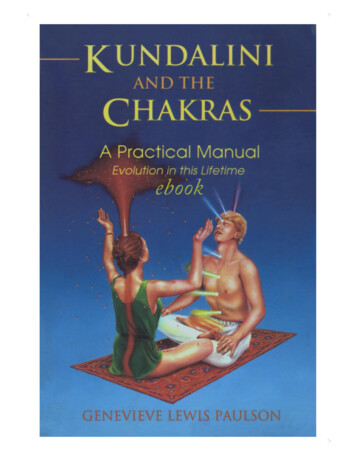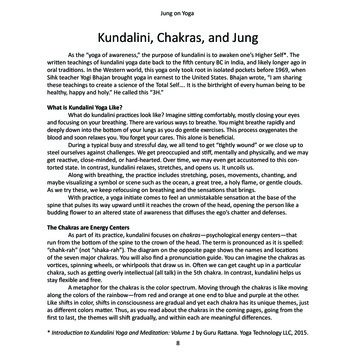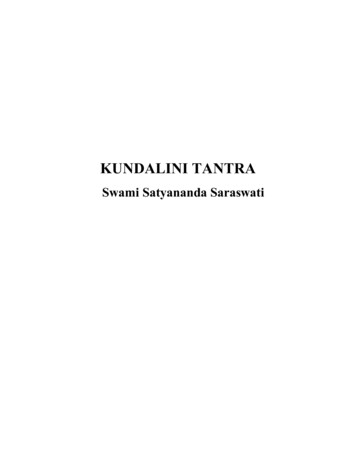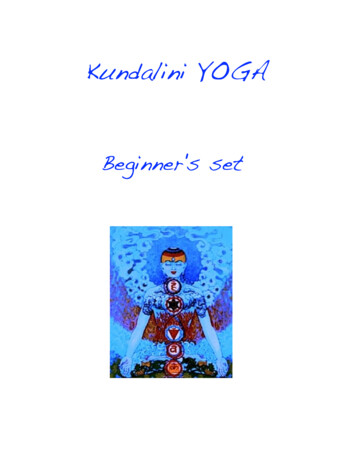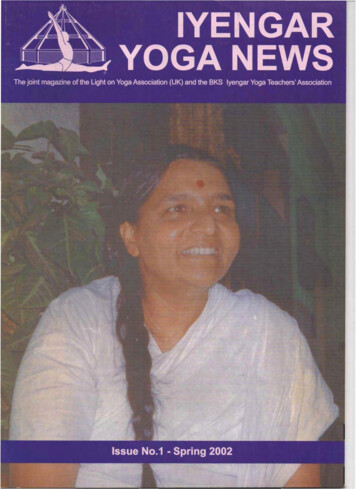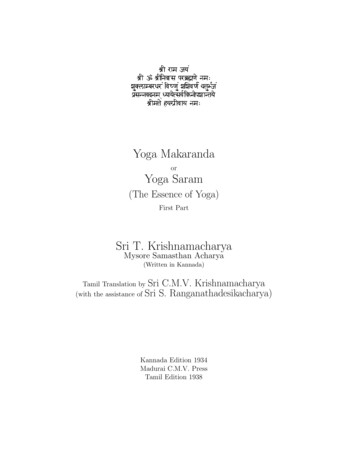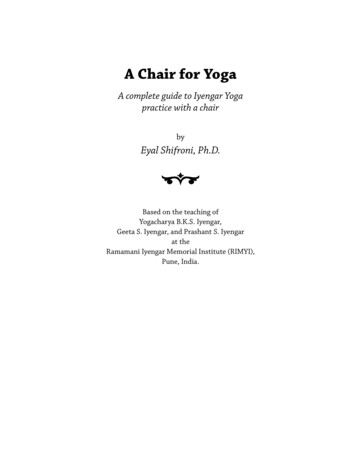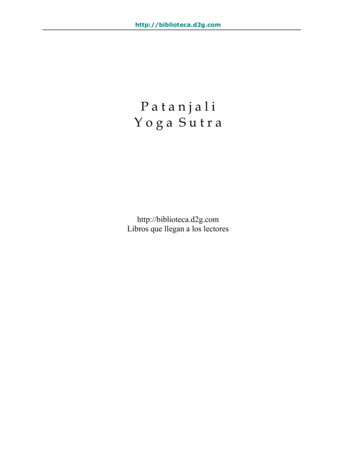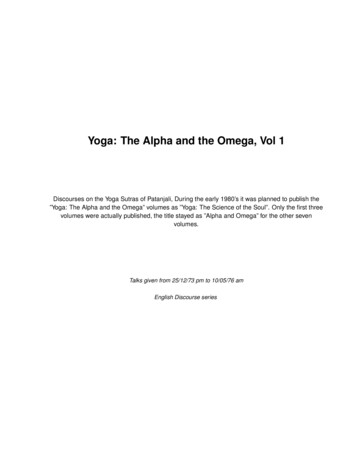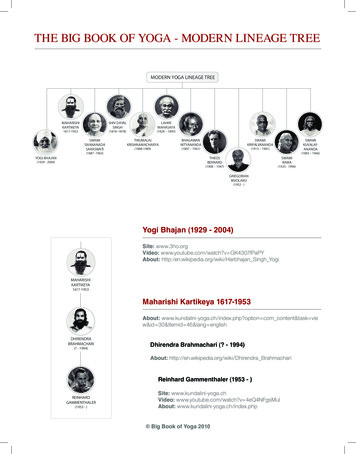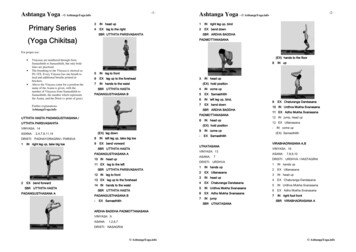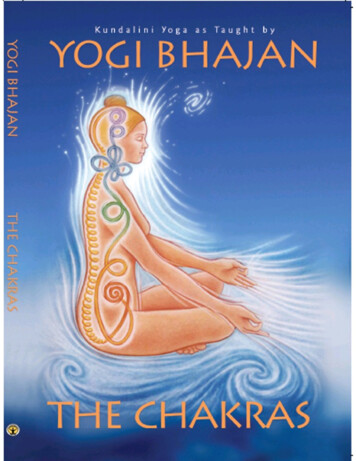
Transcription
The ChakrasKundalini Yoga as taught by Yogi Bhajan TrainingKundalini Research InstitutePublishingResearchResources
2012 Kundalini Research InstitutePublished by the Kundalini Research InstituteTraining Publishing Research ResourcesPO Box 1819Santa Cruz, NM 87532www.kundaliniresearchinstitute.orgISBN: 978-1-934532-86-7Editor: Sat Purkh Kaur KhalsaConsulting Editor: Nirvair Singh KhalsaKRI Review: Siri Neel Kaur KhalsaCopy Editor: Michelle Starika AsakawaGurmukhi Editor: Ek Ong Kaar Kaur KhalsaDesign & Layout: Prana Projects, Ditta Khalsa and Biljana NedelkovskaCover Design: Ravitej Singh Khalsa, Khalsa Marketing GroupPhotography: Ravitej Singh KhalsaCover & Interior Illustrations: Hector Jara Mukhtiar Singh. Used with Permission.Model: Sat Siri KaurThe diet, exercise and lifestyle suggestions in this book come from ancient yogic traditions. Nothing in this book should be construed asmedical advice. Any recipes mentioned herein may contain potent herbs, botanicals and naturally occurring ingredients which havetraditionally been used to support the structure and function of the human body. Always check with your personal physician or licensedhealth care practitioner before making any significant modification in your diet or lifestyle, to insure that the ingredients or lifestylechanges are appropriate for your personal health condition and consistent with any medication you may be taking. For more informationabout Kundalini Yoga as taught by Yogi Bhajan please see www.yogibhajan.org and www.kundaliniresearchinstitute.org. 2012 Kundalini Research Institute. All teachings, yoga sets, techniques, kriyas and meditations courtesy of The Teachings of YogiBhajan. Reprinted with permission Unauthorized duplication is a violation of applicable laws. ALL RIGHTS RESERVED. No part ofthese Teachings may be reproduced or transmitted in any form by any means, electronic or mechanical, including photocopying andrecording, or by any information storage and retrieval system, except as may be expressly permitted in writing by the The Teachings ofYogi Bhajan. To request permission, please write to KRI at PO Box 1819, Santa Cruz, NM 87567 or seewww.kundaliniresearchinstitute.orgThis publication has received the KRI Seal of Approval. This Seal is only given to products that have been reviewed for accuracy andintegrity of the sections containing 3HO lifestyle teachings and Kundalini Yoga as taught by Yogi Bhajan
“The criteria is that if you can practice and understand these chakras, and develop themautomatically in your body so they become your companions, then you have seven friends.”Yogi Bhajan
Table of ContentsNote from the Kundalini Research InstituteBefore You BeginThe First ChakraLecture from January 22, 1991Lecture from January 23, 1991First Chakra KriyaThe Second ChakraLecture from January 29, 1991Lecture from January 30, 1991Second Chakra KriyaThe Third ChakraLecture from February 5, 1991Lecture from February 6, 1991Third Chakra KriyaThe Fourth ChakraLecture from February 12, 1991Lecture from February 13, 1991Fourth Chakra KriyaArti KriyaThe Fifth ChakraLecture from February 19, 1991Lecture from February 20, 1991Fifth Chakra KriyaThe Sixth ChakraLecture from March 5, 1991Lecture from March 6, 1991
Chaar Padh MeditationMeditation on Being a YogiThe Seventh ChakraLecture from April 9, 1991Lecture from April 10, 1991Hissing Meditation for the Glandular System IHissing Meditation for the Glandular System IIEpilogueAbout Yogi BhajanGlossaryResourcesIndex
A Note from the Kundalini Research InstituteThis manual was created to accompany Yogi Bhajan's Chakra DVD Series, a powerful collection of lectures and meditations that willexpand your current definition of the chakras: how they interact with one another and within you. The edited lectures collected hereshould not be considered transcripts, but instead are aids to furthering your study and deepening your understanding of Kundalini Yogaand its relationship to the chakras. We encourage you to study with the Master of Kundalini Yoga, Yogi Bhajan, directly through theaccompanying Chakra DVD series. The impact of a spiritual master does not translate onto the page. As much as we try to capture thespirit of his teachings in our pursuit of accuracy, cultivating your own relationship to the Master and his teachings is the only way to trulyexperience them for yourself.
Before You BeginBeginning Your Practice—Tuning-InThe practice of Kundalini Yoga as taught by Yogi Bhajan always begins by tuning-in. This simplepractice of chanting the Adi Mantra 3-5 times, aligns your mind, your spirit and your body to becomealert and assert your will so that your practice will fulfill its intention. It's a simple bowing to yourHigher Self and an alignment with the teacher within. The mantra may be simple but it links you to aGolden Chain of teachers, an entire body of consciousness that guides and protects your practice:OngNamo Guroo Dayv Namo, which means, I bow to the Infinite, I bow to the Teacher within.How to EndAnother tradition within Kundalini Yoga as taught by Yogi Bhajan is a simple blessing known asThe Long Time Sun Shine song. Sung or simply recited at the end of your practice, it allows you todedicate your practice to all those who've preserved and delivered these teachings so that you mighthave the experience of your Self. It is a simple prayer to bless yourself and others. It completes thepractice and allows your entire discipline to become a prayer, in service to the good of all.May the long time sun shine upon youAll love surround youAnd the pure light within youGuide your way on.Sat Naam.Other Tips for a Successful ExperiencePrepare for your practice by lining up all the elements that will elevate your experience: naturalfiber clothing and head covering (cotton or linen), preferably white to increase your auric body;natural fiber mat, either cotton or wool; traditionally a sheep skin or other animal skin is used. If youhave to use a rubber or petroleum-based mat, cover the surface with a cotton or wool blanket toprotect and support your electromagnetic field. Clean air and fresh water also helps support yourpractice.
Practice in CommunityKundalini Yoga cultivates group consciousness, because group consciousness is the first steptoward universal consciousness, which is the goal: transcend the ego and merge with Infinity. Find ateacher in your area at http://www.3HO.org/ikyta/. Studying the science of Kundalini Yoga with aKRI certified teacher will enhance your experience and deepen your understanding of kriya, mantra,breath and posture. If there isn't a teacher in your area, consider becoming a teacher yourself. Thereare Aquarian Teacher Trainings all over the world. Go to www.kundaliniresearchinstitute.org formore information.Bandhas1Bandhas or locks are used frequently in Kundalini Yoga. Combinations of muscle contractions,each lock has the function of changing blood circulation, nerve pressure, and the flow of cerebralspinal fluid. They also direct the flow of psychic energy, praana, into the main energy channels thatrelate to raising the Kundalini energy. They concentrate the body's energy for use in consciousnessand self-healing. There are three important locks: jalandhar bandh, uddiyana bandh, and mulbandh.When all three locks are applied simultaneously, it is called maahaabandh, the Great Lock.Jalandhar Bandh or Neck LockThe most basic lock used in Kundalini Yoga is jalandhar bandh, the neck lock. This lock is practicedby gently stretching the back of the neck straight and pulling the chin toward the back of the neck. Liftthe chest and sternum and keep the muscles of the neck and throat and face relaxed.Uddiyana Bandh or Diaphragm LockApplied by lifting the diaphragm up high into the thorax and pulling the upper abdominal musclesback toward the spine, uddiyana bandh gently massages the intestines and the heart muscle. The spineshould be straight and it is most often applied on the exhale.Applied forcefully on the inhale, it can create pressure in the eyes and the heart.Mool Bandh or Root LockThe Root Lock is the most commonly applied lock but also the most complex. It coordinates andcombines the energy of the rectum, sex organs, and navel point.
Mool is the root, base, or source. The first part of the mool bandh is to contract the anal sphincterand draw it in and up as if trying to hold back a bowel movement. Then draw up the sex organ so theurethral tract is contracted. Finally, pull in the navel point by drawing back the lower abdomentowards the spine so the rectum and sex organs are drawn up toward the navel point.Pronunciation GuideThis simple guide to the vowel sounds in transliteration is for your convenience. Gurbani is a verysophisticated sound system, and there are many other guidelines regarding consonant sounds and otherrules of the language that are best conveyed through a direct student-teacher relationship. Furtherguidelines regarding pronunciation are available at utmomput, sootpoolfinfeetlethay, rainflick tongue on upper palate1Adapted from Kundalini Yoga Sadhana Guidelines, 2nd Edition
The First Chakra
January 22, 1991I am going to share with you certain things that you cannot find either from a normal Yogior a great Yogi or a highly qualified Yogi, normal or abnormal, or from any Yogic book.But the way I will explain it and talk about it will be very human. I am going to talk aboutthe chakras. No human being, no matter what religion you belong to, who you follow, whoyou love, what your blessings are, what your face is, what your shape is, no human can behappy, granted, I mean to say, period. I don't care how many degrees you have or how sexyyou are. These are just your qualifications. You can take every worldly qualification—howrich you are, how powerful you are, you may be the President of the United States or youmay be a peon—any facet of your personality, status, and identity, but you won't findhappiness. Why? Because we do not know how to concentrate.Take this very ordinary thing: you go to bathroom. You feel it, but if you don't concentrate youwon't poop. No, we are talking very frankly here. Nobody can pass one's stool if they don'tconcentrate. So either by necessity or by human urge or by complex, we have learned to concentrateon the First Chakra, but we do it once or twice a day, that's it. That's the maximum we need; beyondthat we forget that it even exists. Secondly, we have to urinate, for which, unfortunately, we don'tconcentrate.Now believe me, it is something which you have to understand very carefully, but when youinvolve yourself sexually with the same kind of mate if you are a gay, or the opposite kind of mate ifyou are heterosexual, then you have to concentrate. You cannot ejaculate if you do not concentrate; butsometimes you ejaculate, and you find out that your prostate has gone wrong or your gonad has gonewrong, this has gone wrong and that has gone wrong. That's a normal, human physical thing. Butessentially there are only two places where you know to concentrate, because these are your dailynecessities, okay? You do not know how to concentrate on the navel point because you don't need it,you don't want it. It is just a part of your physical existence, but you do not know what it is all about.What is a navel point? Nobody has put lipstick around it yet; I mean to say, they are not glorifyingit. They don't even recognize it, this point called navel point. But remember this, it is the third centerof your entire being, and it is the center of the apaana. All your body's elimination is because of that,and it is responsible for bringing home your old age. Your total physical strength, your projection,and your reality are based on this center, and you do not know about it; you don't touch it, you don'tpump it, you don't feel it, you don't bother about it, it's not important.Now, if you are a Christian or you are a Moslem or you are a Hindu or you are a Sikh or you areFrench or you are German, you cannot be without the navel point. It exists. For five thousand years allthe great men—men of great knowledge—actually worked out everything about these chakras: theirworks, their petals, their sounds, their Infinity, their co-relationship, their coordination. There is a
whole science, and this total science gave birth to Kundalini Yoga. That's how Kundalini Yoga wasborn. They found out what the chakras are and where lies the human's central powers. Then they foundout what is the human—not the central power—but what the human is. They found out that the humanis based in these chakras, these seven chakras are in the body of the human. Then they looked at thecoordination of it, and they found out there is a Heart Center: what it does, what its color is, whatcompassion is. These are all symbolic; they are indications, like, if you make a circle with a plussign, it's a woman. These chakras are symbolically described and need explanation, and after youread that explanation you have to know what we are talking about—that's very important. After theHeart Center, then they say there is a Throat Chakra and an Ajana (Agia) Chakra 2; then they say thereis a sahasrara; then they go further, there is an aura; there is an arc line; there are ten bodies, fivetattvas, three gunas, seven chakras, and so on.Why is it important to know about the chakras and to talk about the chakras? Because you don'tconcentrate on the chakras. You only concentrate, as a physical necessity, on two chakras. You don'tconcentrate on your Throat Chakra at all. There is a way of talking which can be very effective; andthere is a way of talking which will not be effective, though you say the same words: “How do youdo?” [with inflection] You see how sexy it is?You can provoke a response. We used to bet, my friends and I, that within fifteen minutes, by yourwatch, you, without your self-control or
expand your current definition of the chakras: how they interact with one another and within you. The edited lectures collected here should not be considered transcripts, but instead are aids to furthering your study and deepening your understanding of Kundalini Yoga and its relationship to the chakras. We encourage you to study with the Master of Kundalini Yoga, Yogi Bhajan, directly through .
